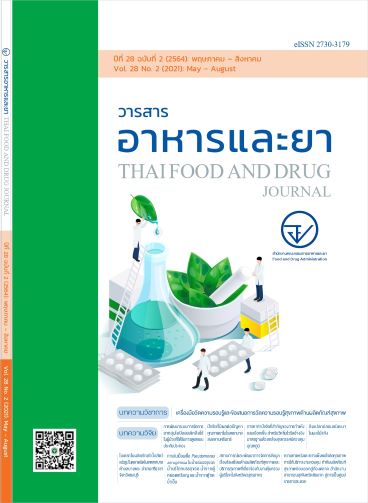การปนเปื้อนเชื้อ Pseudomonas aeruginosa ในน้ำแร่บรรจุขวด น้ำบริโภคบรรจุขวด น้ำจากตู้หยอดเหรียญ และน้ำจากตู้กดน้ำเย็น
Main Article Content
บทคัดย่อ
ความสำคัญ: Pseudomonas aeruginosa เป็นเชื้อฉวยโอกาสที่ก่อให้เกิดการติดเชื้อหรือเกิดโรคในผู้ที่มีภูมิคุ้มกันต่ำสามารถปนเปื้อนได้ในน้ำบริโภค ปัจจุบันมาตรฐานน้ำบริโภคในประเทศไทยไม่ได้กำหนดให้ตรวจเชื้อ P. aeruginosa
วัตถุประสงค์: เพื่อทราบสถานการณ์การปนเปื้อนเชื้อ Coliforms, E. coli และ P. aeruginosa ในน้ำบริโภค และศึกษาความสัมพันธ์ของการพบเชื้อ Coliforms กับ P. aeruginosa ในน้ำบริโภค
วิธีการวิจัย: งานวิจัยนี้ได้ทำการศึกษาการปนเปื้อนเชื้อ P. aeruginosa ในน้ำบริโภค 4 ประเภท ได้แก่ น้ำแร่บรรจุขวด น้ำบริโภคบรรจุขวด น้ำตู้หยอดเหรียญ และน้ำจากตู้กดน้ำเย็น ในกรุงเทพมหานคร ปริมณฑล และอื่น ๆ รวมทั้งตรวจหาเชื้อ Coliforms และ E. coli ที่เป็นแบคทีเรียบ่งชี้สุขลักษณะในการผลิตและถูกกำหนดในมาตรฐานน้ำบริโภค นอกจากนี้ ได้หาความสัมพันธ์ของการพบเชื้อ Coliforms กับ P. aeruginosa ในน้ำบริโภค โดยตรวจวิเคราะห์น้ำบริโภค 91 ตัวอย่างในห้องปฏิบัติการ
ผลการศึกษา: พบว่าน้ำแร่บรรจุขวดไม่พบการปนเปื้อนเชื้อทั้ง 3 ชนิด ส่วนน้ำบริโภคบรรจุขวด น้ำตู้หยอดเหรียญ และน้ำจากตู้กดน้ำเย็น ไม่ผ่านเกณฑ์เชื้อ Coliforms และ E. coli ร้อยละ 4.8, 14.3 และ 15.8 ตามลำดับ และพบการปนเปื้อนเชื้อ P. aeruginosa ร้อยละ 19.1, 77.1 และ 42.1 ตามลำดับ ผลทดสอบทางสถิติพบว่า การปนเปื้อนเชื้อ Coliforms ในน้ำบริโภคมีความสัมพันธ์กับการปนเปื้อนเชื้อ P. aeruginosa ในน้ำบริโภคอย่างมีนัยสำคัญทางสถิติ (p<0.05)
สรุป: น้ำดื่มที่มิใช่น้ำแร่มีการปนเปื้อนเชื้อ P. aeruginosa และการปนเปื้อนมีความสัมพันธ์กับการพบเชื้อ Coliforms ดังนั้น ผู้ที่มีภูมิคุ้มกันต่ำ ทารก เด็กเล็ก ผู้สูงอายุ หรือผู้ป่วย สามารถติดเชื้อ P. aeruginosa จากการบริโภคน้ำดื่มได้ง่าย จึงควรมีการเฝ้าระวัง เชื้อ P. aeruginosa เพื่อป้องกันการเกิดโรค โดยหน่วยงานของรัฐ เช่น สำนักงานคณะกรรมการอาหารและยา เก็บตัวอย่างน้ำบริโภคแต่ละชนิดตรวจเฝ้าระวังการปนเปื้อนเชื้อ P. aeruginosa และราชการส่วนท้องถิ่นดำเนินการออกข้อกำหนดควบคุมการให้บริการตู้น้ำหยอดเหรียญและบังคับใช้ ให้ผู้ประกอบกิจการน้ำบริโภคหรือเจ้าของสถานที่บริการตู้กดน้ำเย็นต้องมีการบำรุงรักษาเครื่องอย่างถูกวิธี
Article Details

อนุญาตภายใต้เงื่อนไข Creative Commons Attribution-NonCommercial-NoDerivatives 4.0 International License.
เอกสารอ้างอิง
World Health Organization. Guidelines for drinking-water quality: 4th ed. Geneva: WHO; 2017.
Water Services Association of Australia. Fact sheet: Pseudomonas aeruginosa [Internet]. Melbourne: WSAA; 2016 [cited 2017 Aug 12]. Available from: http:// www.wsaa.asn.au/sites/default/files/publication/download/Fact%20Sheet_Pseudomonas_Aug16.pdf
Todar K. Pseudomonas [Internet]. Todar’s Online Textbook of Bacteriology; 2008-2012 [cited 2017 Aug 12]. Available from: http://textbookofbacteriology.net/pseudomonas_2.html
Centers for Disease Control and Prevention USA. Guidelines for environmental infection control in health-care facilities [Internet]. GA: DCD; 2003 [cited 2019 July 28]. Available from: https://www.cdc.gov/infectioncontrol/pdf/guidelines/environmental-guidelines-P.pdf
Eckmanns T, Oppert M, Martin M, Amorosa R, Zuschneid I, Frei U, Rüden H, Weist K. An outbreak of hospital-acquired Pseudomonas aeruginosa infection caused by contaminated bottled water in intensive care units. Clin Microbiol Infect 2008;14(5):454-8. doi: 10.1111/j.1469-0691.2008.01949.x. Epub 2008 Feb 22. PMID: 18294245.
Directive 2009/54/EC of the European Parliament and of the Council of 18 June 2009 on the exploitation and marketing of natural mineral waters. Off J Eur Comm L164 2009:45-58. [cited 2019 July 28]. Available from: http://extwprlegs1.fao.org/docs/pdf/eur88493.pdf
Rice EW, Baird RB, Eaton AD, editors. Standard Methods for the Examination of Water and Wastewater. 23rd ed. Washington DC: American Public Health Association; 2017. p. 9-68-75, 9-77-8,9-80,9-112-6.
Bio-Rad. Food science: RAPID'P.aeruginosa agar for water testing [Internet]. Bangkok: Bio-Rad; [cited 2019 July 28]. Available from: https://www.bio-rad.com/en-th/product/rapidp-aeruginosa-agar-for-water-testing?ID=LTN16D4VY
สำนักงานคณะกรรมการอาหารและยา กระทรวงสาธารณสุข. ประกาศกระทรวงสาธารณสุข ฉบับที่ 61 (พ.ศ.2524) เรื่อง น้ำบริโภคในภาชนะบรรจุที่ปิดสนิท. ราชกิจจานุเบกษา ฉบับที่ 98, ตอนที่ 157 (ลงวันที่ 24 กันยายน 2524).
สำนักงานคณะกรรมการอาหารและยา กระทรวงสาธารณสุข. ประกาศกระทรวงสาธารณสุข ฉบับที่ 199 (พ.ศ. 2543) เรื่อง น้ำแร่ธรรมชาติ. ราชกิจจานุเบกษา ฉบับประกาศทั่วไป เล่มที่ 118, ตอนพิเศษ 6 ง (ลงวันที่ 24 มกราคม 2544).
สำนักงานคณะกรรมการอาหารและยา กระทรวงสาธารณสุข. ประกาศกระทรวงสาธารณสุข ฉบับที่ 362 (พ.ศ. 2556) เรื่อง น้ำบริโภคจากตู้น้ำดื่มอัตโนมัติ. ราชกิจจานุเบกษา เล่มที่ 130, ตอนพิเศษ 136 ง (ลงวันที่ 16 ตุลาคม 2556).
Council Directive 98/83/EC on the quality of water intended for human consumption. Offi J Eur Comm. L330, 1998, p. 32-53.
Mohammadi KM, Alimohammadi M, Nabizadeh NR, Aslani H, Rezaie S, Asadian S. Pseudomonas aeruginosa and heterotrophic bacteria count in bottled waters in Iran. Iran J Public Health. 2015;44(11):1514-9. PMID: 26744709; PMCID: PMC4703231.
สำนักงานคณะกรรมการอาหารและยา กระทรวงสาธารณสุข. คู่มือการตรวจสอบและบำรุงรักษาตู้น้ำดื่มอัตโนมัติ. นนทบุรี: สำนักงานคณะกรรมการอาหารและยา กระทรวงสาธารณสุข; 2556.
มติชนออนไลน์. พบตู้น้ำหยอดเหรียญในเมืองนนท์ 30% ไม่ผ่านเกณฑ์คุณภาพจี้ท้องถิ่นเร่งออกข้อบัญญัติควบคุม. [อินเทอร์เน็ต]. กรุงเทพฯ: มติชน; 2561. [เข้าถึงเมื่อ 9 ก.ย. 2562]. เข้าถึงได้จาก: https://www.matichon.co.th/region/news_1237312
Hassen A, Mahrouk M, Ouzari H, Cherif M, Boudabous A, Damelincourt JJ. UV disinfection of treated wastewater in a large-scale pilot plant and inactivation of selected bacteria in a laboratory UV device. Bioresour. Technol. 2000;74(2),141–50. https://doi.org/10.1016/S0960-8524(99)00179-0.
Aspinall ST, Graham R. Two sources of contamination of a hydrotherapy pool by environmental organisms. J. Hosp. Infect. 1989;14(4),285–92. https://doi.org/10.1016/0195-6701(89)90068-6.
Assurity Consulting. What is important to know about drinking water quality: Pseudomonas aeruginosa? [Internet]. West Sussex: Assurity Consulting; 2019 [cited 2019 July 28]. Available from: https://www.assurityconsulting.co.uk/knowledge/guides/what-is-important-to-know-about-drinking-water-quality-pseudomonas-aeruginosa#:~:text=What%20is%20important%20to%20know,if%20found%20in%20high%20numbers
Leclerc H, Moreau A. Microbiological safety of natural mineral water. FEMS Microbiology Reviews 2002;26(2):207–22. doi: 10.111/j.1574-6976.2002.tb00611.x. PIMD: 12069884.
Moritz MM, Flemming HC, Wingender J. Integration of Pseudomonas aeruginosa and Legionella pneumophila in drinking water biofilms grown on domestic plumbing materials. Int. J. Hyg. Environ. Health 2010;213:190-7. 10.1016/j.ijheh.2010.05.003. PMID: 20556878.
Legnani P, Leoni E, Rapuano S, Turin D, Valenti C. Survival and growth of Pseudomonas aeruginosa in natural mineral water: a 5-year study. Int J Food Microbiol. 1999;53(2-3):153-8. doi: 10.1016/s0168-1605(99)00151-8. PMID: 10634706.


